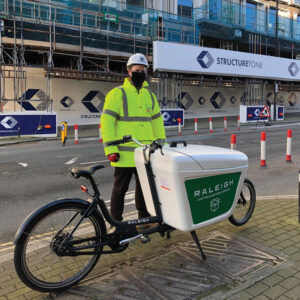Building a Bold, Sustainable Vision in London
“The best air quality in the world.” “The world’s first National Park City.” “A zero carbon, zero waste city.”
Those are just some of the bold goals London Mayor Sadiq Khan announced in 2018 as part of the city’s plan to make London a world leader in sustainability. As he put it at the time, “My aspiration is to help turn London into a zero carbon city by 2050. And I’m committed to working with national government, local boroughs, London’s businesses, NGOs, our European neighbours, and individual Londoners to achieve this goal.”
SETTING NEW STANDARDS
Since then, London has committed to becoming net zero by 2030, and various organisations, including Structure Tone, have joined forces through legislation, designing, sourcing, and utilizing new materials, equipment, and construction techniques to help the city achieve this ambitious goal.
“We’re seeing a complete cultural shift in our industry,” says Kevin Crane, Structure Tone London operations director. “These goals are pushing everyone to do better and adjust our work to help meet these targets, which is good.”
At Structure Tone, this has meant fine-tuning some facets of their operations and approach to projects to meet new, higher standards:
1. Minimum Energy Efficiency Standards. Building projects in London are given an Energy Performance Certificate, or EPC, to identify how energy efficient the building is—from an “A” rating (very efficient) to “G” (inefficient). From a construction perspective, achieving a higher EPC involves integrating efficient MEP, roof, HVAC, and building envelope systems. Structure Tone is currently working with two clients to shift to more efficient MEP systems by replacing aging gas boilers and heating equipment with fully electrified systems and heat pumps, which not only earns them a good EPC rating but will also only continue to improve as more of the city’s electrical supply comes from renewable sources.
2. BREEAM targets. New buildings or complex refurbishment projects are expected to target the “Outstanding” level in the BREEAM (Building Research Establishment Environmental Assessment Method) rating system. Structure Tone has developed several strategies to help projects reach those goals, from responsible materials sourcing to waste recycling to recording project CO2 emissions.
3. The Considerate Constructors Scheme. By signing on to this national code of conduct, Structure Tone has pledged to abide by guidelines on safety, planning and communication, being a liaison and good neighbor to the community, and keeping their jobsites clean and responsibly managed.
THE CARBON CURE
Those three platforms are interconnected and pushing the industry to adapt. An Outstanding BREEAM rating, for example, requires high Considerate Contractors Scheme (CCS) points and EPC ratings. The CCS, in turn, requires carbon disclosure and actions to reduce carbon emissions. Add to that the mandatory and voluntary carbon disclosure many building owners and tenants have employed as part of their own ESG goals, and the entire building community may start to move the needle.

“As a company, we have to report our emissions, emissions from the energy we purchase, how our employees get to work, and how far they travel,” says Crane. “We also have to do that for everyone who works on the job.” For their Rose Court refurbishment project, for example, Structure Tone has calculated over 13,000 vehicle movements a day from their own fleet and that of their subcontractors. To help ease those numbers, the team also got creative, introducing the idea of cargo bikes to transport materials to, from, and around the jobsite. After a few months of using the bikes, the team reduced vehicle movements by about 400, saving around 500kg of CO2. over the course of the project.
“The use of cargo bikes for transport of construction materials by the Rose Court project was ground-breaking and a positive response to the council’s climate emergency,” said Dan Taylor, then programme manager for regeneration at London Borough of Southwark, when the program launched.
CREDIBILITY AND CULTURE
Where the construction industry can make the biggest difference, says Structure Tone sustainability manager Jamie Firman, is materials.
“While the specifications of a job may dictate specific finishes, we can control the supply chain for those materials, and we can suggest alternatives that provide the desired effect with less environmental impact. Considering the whole life cycle of a product, from its extraction and transportation through to its disassembly and reuse, is becoming a key focus.”
Reusing and recycling materials is also key, says Crane. “The circular economy will become even more important to our process,” he says. “Our waste recycling is already near 90% so now we must focus on how we reuse materials on the site.”
The social impact of building projects is also becoming more and more important to building owners and the surrounding communities. Some developers have begun asking contractors to calculate the social value of their approach in their tender responses and are weighing some of the decisions on the company’s culture of social responsibility.
“Clients are setting really ambitious targets and challenging themselves and the market to progress with them,” says Firman. “There’s a lot of traction, and we’re really seeing this tidal shift.”
And, says Crane, for those who don’t truly embrace this movement, opportunities will be lacking. “Without green credibility and a sustainable culture, you won’t be able to win work,” he says. “Ireland is also pushing ahead with this ambitious revolution, and we’re working together with our Dublin office to provide a best-in-class approach for our clients.”
